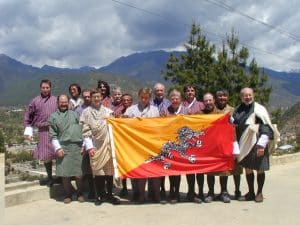Headlines
Bhutan Population, Official Language And More.

Bhutan underwent significant reforms and modernization in the 20th century, especially under the reign of King Jigme Dorji Wangchuk (1952-1972), who abolished slavery, introduced land reforms, education, health care, and infrastructure development. He also initiated the transition from an absolute monarchy to a constitutional monarchy with a parliamentary democracy. In 2008, Bhutan held its first general elections and became a democratic country.

Bhutan
The population: According to the World Bank, Bhutan’s population was estimated at 0.77 million in 2020, which ranked 170th in the world. The population growth rate was 1.2% and the population density was 20 people per square kilometer.
The landmark: Bhutan has many natural and cultural landmarks that attract tourists and pilgrims. Some of the famous ones are:
Tiger’s Nest Monastery: A sacred Buddhist site perched on a cliff above the Paro Valley. It is said that Guru Rinpoche, the founder of Tibetan Buddhism, flew here on a tiger and meditated in a cave.
Punakha Dzong: A majestic fortress and monastery that served as the capital and seat of government until 1955. It is also the site of the coronation and wedding of the current king.
Buddha Dordenma: A giant statue of Buddha made of bronze and gold that overlooks the Thimphu Valley. It is one of the largest Buddha statues in the world and contains 125,000 smaller Buddhas inside.
The official language: The official language of Bhutan is Dzongkha, which is a Tibetan language spoken by about 160,000 people, mainly in western Bhutan. It was declared the national language in 1971. However, there are many other languages spoken in Bhutan, belonging to the Tibeto-Burman family, such as Bumthang, Kheng, Kurtöp, Sharchop and Nepali.
The culture: Bhutan’s culture is influenced by Tibetan, Chinese and Indian cultures, but has its own distinctive features. The culture is based on sacred Buddhist values and traditions, such as respect for elders, compassion for all living beings, reverence for nature, and pursuit of happiness. Some of the aspects of Bhutanese culture are:
Dress: Bhutanese men wear gho, which are long robes tied around the waist by a belt, and women wear kira, which are ankle-length dresses with jackets. These are the national dress and are worn on formal occasions and in government offices.
Food: The staple food is red rice, which is often accompanied by dishes made with meat, cheese, chilies and vegetables. Some of the popular dishes are ema datshi (chili and cheese stew), momo (dumplings), jasha maru (spicy chicken curry), and thukpa (noodle soup).
Festivals: Bhutan celebrates many festivals throughout the year, most of them related to Buddhism. Some of the major festivals are Losar (Tibetan New Year), Tshechu (honoring Guru Rinpoche), Paro Tsechu (featuring masked dances), Thimphu Tsechu (the biggest festival in the capital), and Haa Summer Festival (showcasing local culture and cuisine).
The economic stability: Bhutan has maintained a solid macroeconomic performance in recent years, driven by large investments in hydropower projects and supportive fiscal and monetary policies. The GDP growth rate averaged 7.5% since the 1980s and reached 5.5% in 2016. The inflation rate was low at 3.2% in 2016 and the exchange rate was stable against the Indian rupee. The international reserves were sufficient to cover more than one year of imports. However, Bhutan faces some challenges to diversify its economy beyond hydropower and tourism, such as improving infrastructure, human capital, governance and trade competitiveness. Bhutan also experienced a trade deficit and rising import costs due to its dependence on imports of fuel, food and consumer goods.
The GDP: The gross domestic product (GDP) of Bhutan is the total value of all goods and services produced in the country in a given year. According to the World Bank, Bhutan’s GDP was $2.6 billion in 2020, which ranked 165th in the world.
The currency: The currency of Bhutan is the ngultrum (BTN), which is divided into 100 chhertum. The ngultrum is pegged to the Indian rupee (INR) at par, meaning one ngultrum equals one rupee. The ngultrum was introduced in 1974, replacing the rupee as the legal tender.
The food: The food of Bhutan is influenced by Tibetan, Chinese and Indian cuisines, but has its own distinctive features. The staple food is red rice, which is often accompanied by various dishes made with meat, cheese, chilies and vegetables. Some of the popular dishes are ema datshi (chili and cheese stew), momo (dumplings), jasha maru (spicy chicken curry), and thukpa (noodle soup) .
Major cities: The major cities of Bhutan are Thimphu, Phuntsholing, Paro, Punakha and Samdrup Jongkhar. Thimphu is the capital and largest city, with a population of about 115,000. It is the political, cultural and economic center of the country. Phuntsholing is the second largest city and the main commercial hub, located on the border with India. Paro is the third largest city and the site of the only international airport in Bhutan. Punakha is the former capital and a historical and religious site. Samdrup Jongkhar is a town in the southeast that serves as a gateway to eastern Bhutan .
Major airport, sea port and schools: Bhutan has four airports, but only one of them, Paro International Airport, serves international flights. It is located about 6 km from Paro and operates flights to India, Nepal, Bangladesh, Thailand and Singapore. Bhutan is a landlocked country and does not have any sea ports. However, it has access to Indian ports through bilateral agreements. The nearest major port is Kolkata in West Bengal. Bhutan has a network of public and private schools that offer primary, secondary and tertiary education. The Ministry of Education oversees the curriculum and standards of education. Some of the notable schools are Royal Thimphu College, Sherubtse College, Royal Institute of Management and Jigme Namgyel Engineering College .





